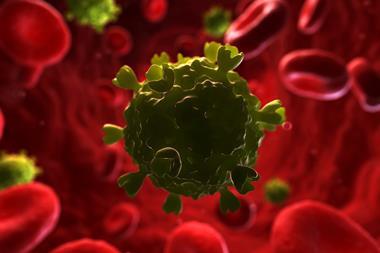Peptide-coated superparamagnetic beads latch onto herpes simplex virus-1 in rapid diagnostic assay

A new assay for spotting the virus responsible for cold sores has been developed by scientists in Ireland.
It is estimated that between 60–95% of adults worldwide are infected with the herpes simplex virus-1 (HSV-1) and although the symptoms are usually limited to sores or blisters, in rare cases it can infect the central nervous system, which is fatal in 70% of untreated cases. If diagnosed early, antiviral therapy can lead to a positive outcome, thus emphasising the need for rapid diagnostic methods.
At present, the most definitive HSV-1 test involves cell cultures but results can take up to a week to complete. Alternative assays have been proposed but they still remain time-consuming and introduce additional complications, like the need for specialist personnel.
The new test devised by Gil Lee and colleagues at University College Dublin uses beads, composed of iron oxide nanoparticles, coated with peptides that bind to the virus. As the nanoparticles are also superparamagnetic, a simple magnet can accelerate their aggregation and the way in which these aggregations scatter light is measured and used to indicate an infection. ‘We knew that a magnetic bead assay had the potential to be very sensitive based on our previous work with Dengue,’ explains Lee. ‘However, HSV is among the most difficult viruses to detect with this technique because it is a relatively large virus and has a complex and irregular membrane coat.’

Peptide receptors are central to the method’s success. While antibody recognition is integral to many diagnostic tests, they require the patient to have had a previous immune response to the virus, so peptides that capture the virus itself therefore offer a convenient and inexpensive alternative. The fact that these beads aggregate increases the sensitivity of this method to 200 copies per ml of sample and enables it to complete within minutes rather than hours.
‘It is interesting that since the assay methodology is rapid and label-free, it may be suitable for point-of-care applications in hospitals or doctors’ offices,’ says Ruben Carbonell of North Carolina State University, US, an expert in using peptides for pathogen detection. ‘While there is still a lot of work to be done to establish this technique as a validated analytical procedure, its advantages hold a great deal of promise for wider application.’
The team are optimistic that their assay will be used to improve point-of-care treatment of HSV, particularly in developing countries, by reducing the cost of diagnosis. They are also keen to expand this research to other viral diseases such as HIV, which requires life-long monitoring.
References
This article is free to access until 27 November 2014. Download it here:












No comments yet